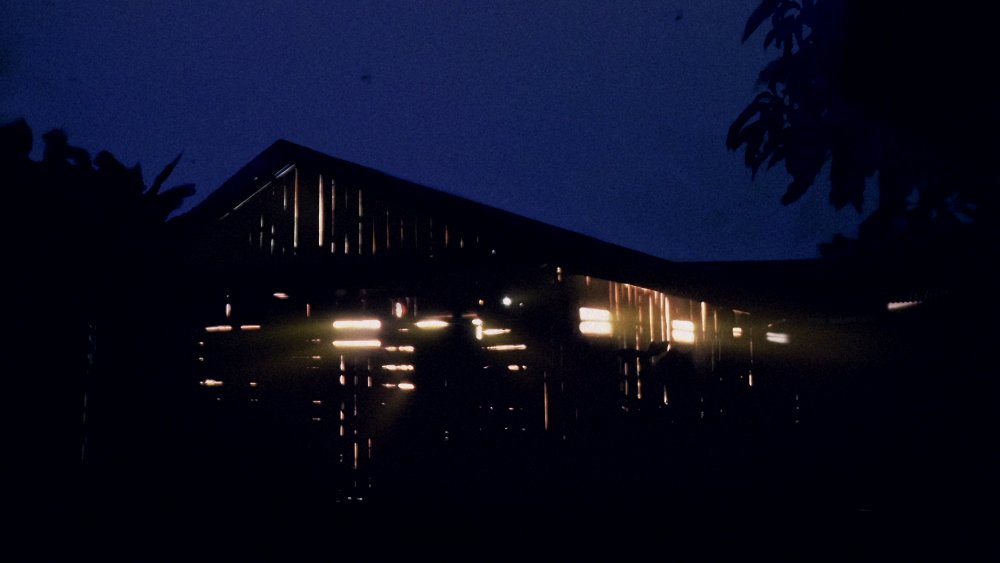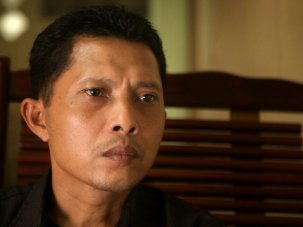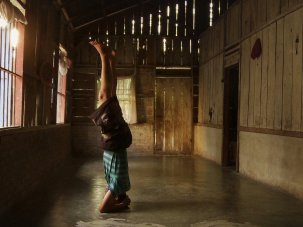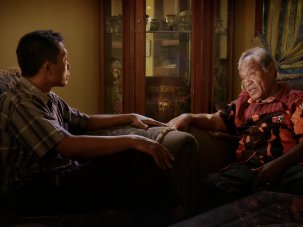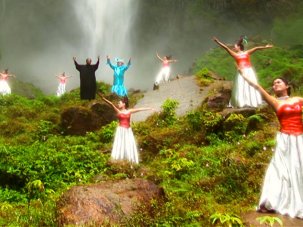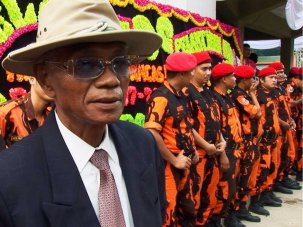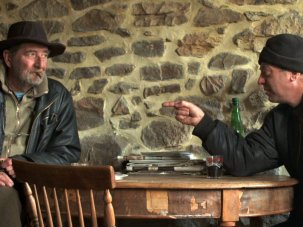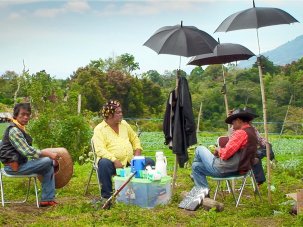“You asked much deeper questions than Joshua ever did,” the old man being fitted for glasses says to his interlocutor Adi, a door-to-door ophthalmologist working around the village of Medan.
Denmark / Norway / Finland / United Kingdom / USA / Germany / The Netherlands 2014
Certificate 15 103m 29s
Director Joshua Oppenheimer
In Colour
[1.85:1]
Subtitles
UK release date 12 June 2015
Distributor Dogwoof
thelookofsilence.co.uk
► Trailer
The old man, Inong, is uncomfortable. He has just been talking about his participation in Indonesia’s anti-communist purge of 1965-66, in which he was a death-squad leader. He has offered up his memories, describing the taste of blood (“both salty and sweet”), as well as his memory of what a woman’s sawn-off breast looks like (“a coconut-milk filter”). This is a unique insight that not everyone is privy to, but his questioner seems insufficiently grateful for what he’s being offered and the conversation becomes standoffish. Unbeknown to Inong, Adi’s older brother Ramli was one of hundreds of ‘undesirables’ in the area listed as communists – that’s to say any enemies of the government installed after the military coup – who were rounded up, butchered and unceremoniously dumped in the Snake River, just some of the million who disappeared nationwide. In fact, only a couple of years before Adi was born, Inong murdered Ramli with his own hands.
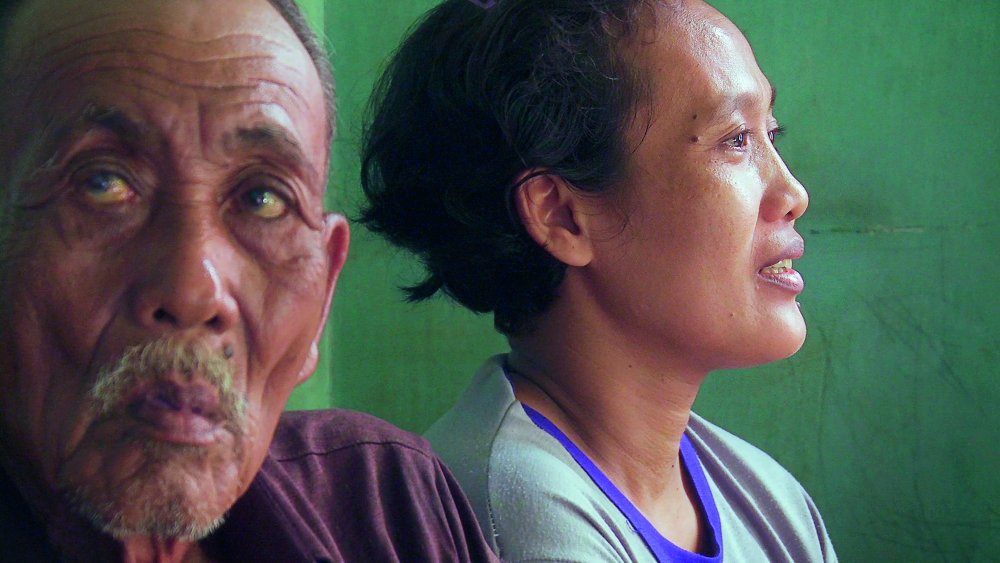
One of the film’s murderers, with his daughter, after he has divulged details of the terror and brutaility on which his heroic reputation rests
The Joshua referred to is Joshua Oppenheimer who, with The Look of Silence, has now produced his second film about the legacy of the purge killings, following 2012’s lauded The Act of Killing. In that film, Oppenheimer handled the interviewing duties himself, in the process of collaborating with small-time gangsters-turned-mass-murderers Anwar Congo and Adi Zulkadry as they produced a cinematic spectacular re-enacting their endeavours, casting themselves as Guys and Dolls toughs in a community theatre as truth and reconciliation committee project that called into question both truth and reconciliation.
In The Look of Silence, Oppenheimer has a new collaborator, Adi Rukun, who belongs by birth to the losing side of the putsch a half century ago, and who is both ennobled by its vanquishing and irreparably wounded by it. Aside from being a metaphor for historical myopia that would be considered much too on-the-nose in fiction filmmaking, Adi’s profession gives him a pretext to enter homes and make ‘small talk’, and a means to keep his subject captive behind a portable phoropter.
Adi gives Oppenheimer an onscreen moral anchor. The ‘look’ referred to in the title belongs to him. It’s his expression as we watch him watching the testimony of the killers on a small television set, much as Congo watched the rushes of his film in The Act of Killing. It’s the deadpan front he puts on as he listens to the killers, the very same men who spoke proudly to Oppenheimer of their actions, openly contradicting what they have happily confessed to elsewhere, as he lets them flounder in dead air or resort to thinly veiled threats.
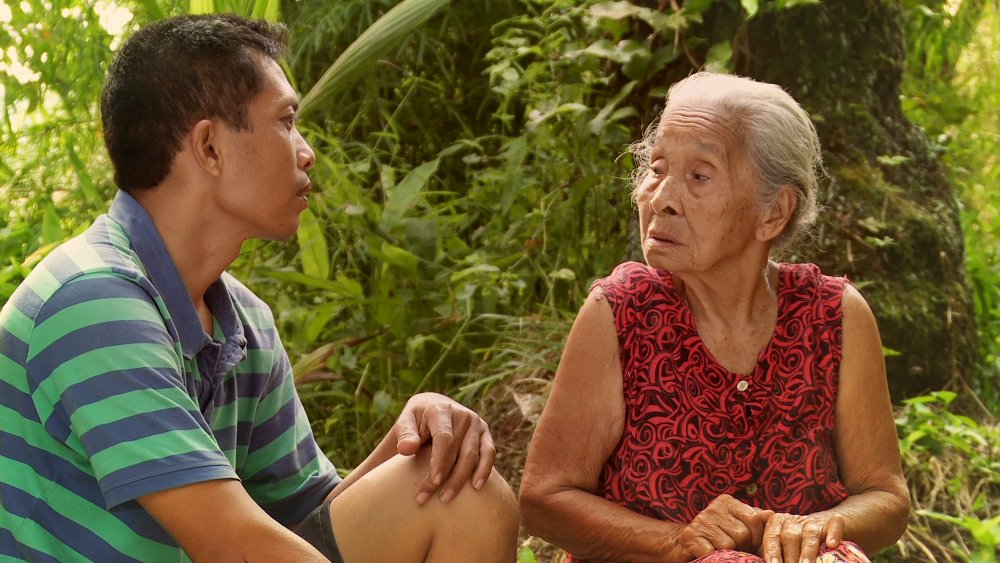
Adi with his mother Rohani
Oppenheimer is Texas-born, Denmark-based, educated at Harvard and Central St Martin’s, London, and fluent in the Indonesian language, but he is not and will never be Indonesian. His outsider status is the fundamental difference between The Act of Killing and the identifiable precedents, films that invite their subjects’ active participation as a form of covert interrogation – for example, Walter Heynowski and Gerhard Scheumann’s The Laughing Man (1966), starring ex-Nazi soldier of fortune Siegfried Müller, or Robert Kramer and Thomas Harlan’s Our Nazi (1984), in which the son of anti-Semitic filmmaker Veit Harlan lured former SS-Obersturmbannführer Dr Alfred Filbert into a movie project that was actually a trap. More recently, one can point to Eliane Raheb’s excellent piecing together of the Lebanese Civil War’s wreckage Sleepless Nights, released the same year as The Act of Killing but overshadowed by that film’s celebrity endorsements from Errol Morris and Werner Herzog.
Oppenheimer’s outsider status, aside from giving him access to high-profile backers and a safety his intrepid collaborators don’t enjoy, confers other advantages. Among these is his privileged vantage on national myth-making – he draws out certain phrases that recur with clockwork regularity, as though multiple subjects, without consulting, are working from the same well-memorised script. In The Act of Killing, it’s the repetition of the fact that the word ‘gangster’ means ‘free man’; in The Look of Silence, it’s the idea that the purge was a “spontaneous action of the people”, a phrase mouthed numerous times without ever once being stated with conviction. These are words that convey silent consent: “I never knew…”
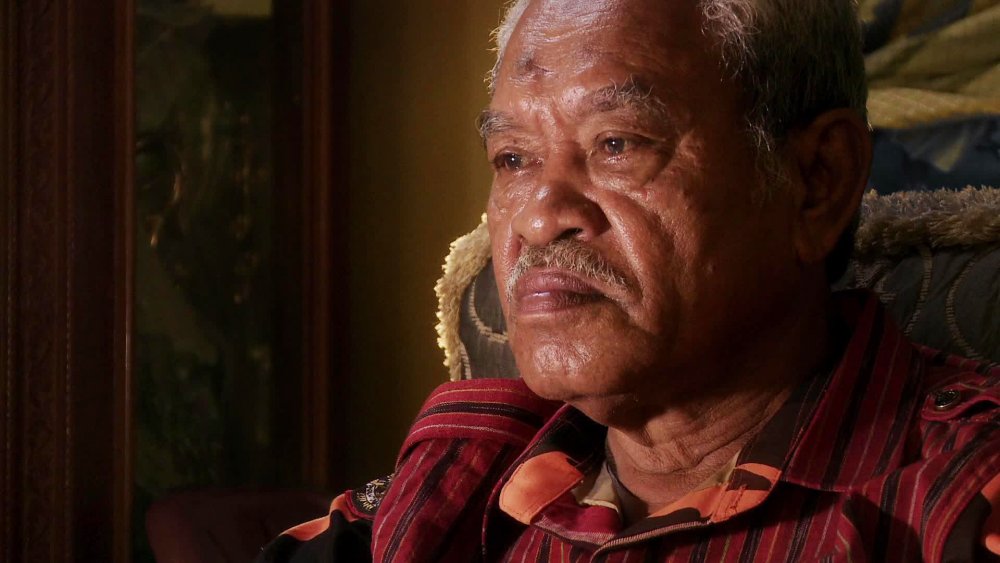
A former leader of the Komando Aksi killing squad
Coming as it does on the heels of The Act of Killing, The Look of Silence may be received as a ‘sequel’ to that film, or perhaps a means to address the few criticisms that accompanied the almost unanimous praise it received, the spirit of most of these being that in starring the perpetrators of atrocities it did a disservice to the victims.
The chronology with which the films were made complicates matters. Oppenheimer began filming in Indonesia in 2004; this is apparently when he shot the footage, which we see at the beginning and throughout the movie, of Inong and his murderous partner Amir Hasan on the banks of the Snake River, discussing their actions and even pantomiming re-enactments with the kind of recall that suggests these are cherished memories. One might say that The Act of Killing and The Look of Silence, having developed on parallel tracks, are two halves of a diptych – or uneasy neighbours, like the former members of the Komando Aksi killing squads and their families, and the families of their victims.
If we allow the wisdom of the idea that the past is another country, then Adi is also a foreigner in his way, since the events he’s inquiring about occurred before he came into the world, though they profoundly shape the present. But 50 years is a long time. The bereaved and the triumphant have both grown old. Some, like Hasan, died peacefully before Adi had the chance to confront them. Hasan is ‘present’ through interview material filmed by Oppenheimer, as well as in the form of an illustrated diary in which he depicted his actions in the “heroic struggle”. The purpose of creating such a keepsake, he says in one of the videos, was “so people will remember us… Our descendants”. Later, however, when Adi presents this piece of physical evidence to Hasan’s surviving family, they reject it outright. In The Act of Killing, Oppenheimer put killers off balance by encouraging them to play-act; in The Look of Silence, he indulges a common fondness for karaoke and musical performance. “Why should I spin yarn if in the end the yarn will be cut?” Hasan sings in one of the film’s first images. “Why should I remember if remembering only breaks my heart?”
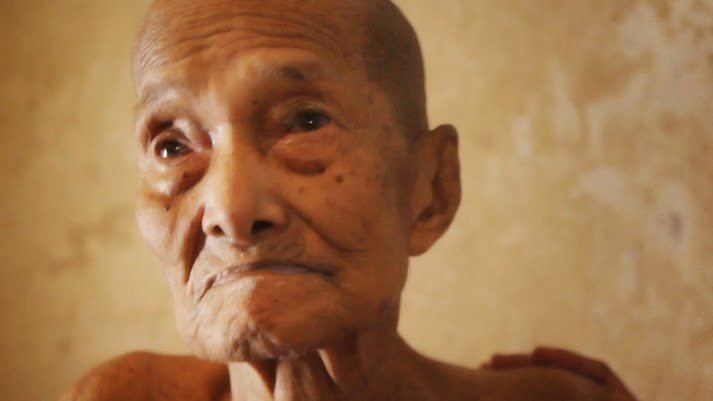
Adi’s father Rukun
People, like nations, remember what they want to remember, while the past is only as far off as we make it. Adi’s father – toothless, hairless, his usually unclothed body resembling a bundle of dry sticks – says he is 17 years old, while Adi’s mother reckons he must be closer to 140. When asked if he remembers Ramli, the old man scarcely understands the question. The only time we see Adi’s cool resolve falter is when he is speaking to one of the killers in the presence of the man’s daughter. The killer’s memory is sharp when recounting his exploits but otherwise he is gone: “Senile,” the daughter says. Adi offers her and the old man forgiveness, though there’s something ironic in giving this gift to someone unequipped to understand what they’re being given, or even what they’re being forgiven for.
No such absolution comes to Inong, who explains that the executioners drank their victims’ blood during the killings to prevent themselves from going insane afterwards. Whatever effect this may have had, one suspects that the money paid out for services rendered helped even more – the killers live and die in comfort, having taken their reward in this world rather than gambling on the next. Running through Oppenheimer’s second film about the communist purge – both more intimate and more philosophical than its predecessor – is an acute awareness of the universal purge that ends all life on earth, that final enforcer of equality between victim and killer.
In the July 2015 issue of Sight & Sound

The atrocity exhibition
While Joshua Oppenheimer’s The Act of Killing explored the savagery of the Indonesian massacres of 1965-66 from the perspective of its unrepentant perpetrators, his confrontational new documentary The Look of Silence examines the experience of its victims. By Nick Bradshaw.
Plus: Changing fortunes
While it’s clear that documentaries have enjoyed a surge in popularity in the past few years, inflated claims about their ability to effect social change don’t stand up to scrutiny. By Brian Winston.
-
Sight & Sound: the July 2015 issue

The Other Side of Orson Welles, plus Amy, The Look of Silence, The Misfits, the best of Cannes and the S&S Interview with John Boorman.
-
The Digital Edition and Archive quick link
Log in here to your digital edition and archive subscription, take a look at the packages on offer and buy a subscription.





